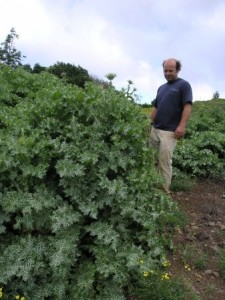(Silybum marianum)
Family: Asteraceae

Blessed milk thistle, or Silybum marianum, isn’t so holy when it forms prickly, invasive thickets. Conservationists quick to eradicate it from Maui pastures. Photo courtesy of Maui Invasive Species Committee
This thistle is native to the Mediterranean regions of Europe and North Africa. Milk thistle thrives in high fertility soils and moist areas such as riverbeds and pastures. It’s a common weed in the Western U.S. and is a noxious weed in Washington and Oregon.
Description:
- Robust, fast growing thistle that can grow to 2-6 feet tall
- It has purple flowers (1.5″ to 2″ long) that are surrounded by long spines.
- Its shiny green leaves have distinctive white veins, which give them a mottled appearance
- The wavy leaf margin is covered in spiny edges
Harm:
- Milk thistle produces copious amounts of seeds (6,000 per plant) and has large leaves which will shade out other plants.
- It also contains high levels of nitrate which are poisonous to ruminant animals such as cattle and sheep. Seeds remain viable in the soil for up to 9 years and the plant thrives in disturbance, making eradication difficult.
- Thistle seeds have tiny tufts of hair (like dandelion seeds) which aid in wind dispersal. It can be spread accidentally in cattle feed, water, mud, vehicles, machinery, erosion and by animals.
In Hawaii:
- Maui – Only known from a naturalized population in the Makawao area of Maui. MISC is working to eradicate the populations. Rarely cultivated as an ornamental, blessed milk thistle is more commonly grown for its medicinal properties. If you see this plant anywhere on Maui, please report it.
Don’t confuse with:
- Mexican poppy, also known as prickly poppy, (Argemone mexicana), is a widespread weed on Maui with similar green and white mottled leaves. It can be differentiated by its yellow poppy-like flowers (2.5” wide), and skinnier leaves. It produces a bright yellow sap when the leaves or stems are broken.
- Bull thistle, (Cirsium vulgare), is a widespread weed on Maui that also has a purple flower and similar growth form. However, bull thistle has uniformly green leaves covered with small bumps.
For more information, see:
- Blessed Milk Thistle article for MISC Kia’i Moku column
